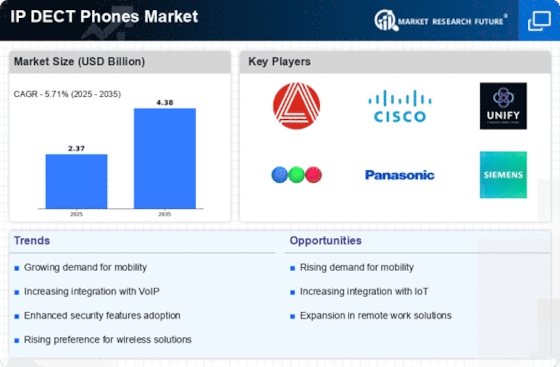The IP DECT Phones Market is currently characterized by a dynamic competitive landscape, driven by technological advancements and evolving consumer preferences. Major players such as Avaya (US), Cisco (US), and Unify (DE) are strategically positioning themselves through innovation and partnerships. Avaya (US) has focused on enhancing its product offerings with advanced features that cater to the growing demand for seamless communication solutions. Cisco (US), on the other hand, emphasizes digital transformation, integrating its DECT solutions with cloud-based services to provide enhanced connectivity. Unify (DE) appears to be leveraging its strong European presence to expand its market share, particularly in the enterprise segment, by offering tailored solutions that meet specific regional needs. Collectively, these strategies contribute to a competitive environment that is increasingly focused on technological integration and customer-centric solutions.
In terms of business tactics, companies are increasingly localizing manufacturing and optimizing supply chains to enhance efficiency and reduce costs. The market structure is moderately fragmented, with several key players holding significant shares while also facing competition from emerging companies. This fragmentation allows for a diverse range of products and services, catering to various customer segments. The collective influence of these key players shapes market dynamics, as they continuously adapt to changing consumer demands and technological advancements.
In August 2025, Avaya (US) announced a strategic partnership with a leading cloud service provider to enhance its DECT phone offerings. This collaboration aims to integrate advanced AI capabilities into their devices, allowing for improved user experiences and operational efficiencies. The significance of this move lies in Avaya's commitment to staying at the forefront of technological innovation, which is crucial in a market that increasingly values smart solutions.
In September 2025, Cisco (US) launched a new line of IP DECT phones designed specifically for remote work environments. This product line features enhanced security protocols and user-friendly interfaces, catering to the growing trend of hybrid work models. The strategic importance of this launch is evident, as it positions Cisco to capture a larger share of the market by addressing the specific needs of businesses adapting to new work paradigms.
In July 2025, Unify (DE) expanded its operations into the Asia-Pacific region, establishing a new manufacturing facility in Vietnam. This strategic move not only localizes production but also enhances supply chain reliability, allowing Unify to respond more swiftly to market demands. The implications of this expansion are profound, as it enables Unify to tap into emerging markets while reducing logistical challenges associated with international shipping.
As of October 2025, current competitive trends in the IP DECT Phones Market are heavily influenced by digitalization, sustainability, and AI integration. Companies are increasingly forming strategic alliances to enhance their technological capabilities and market reach. The shift from price-based competition to a focus on innovation and technology is evident, as firms prioritize developing reliable supply chains and advanced features that meet evolving consumer expectations. Looking ahead, competitive differentiation will likely hinge on the ability to innovate and adapt to technological advancements, ensuring that companies remain relevant in a rapidly changing market.


















Leave a Comment